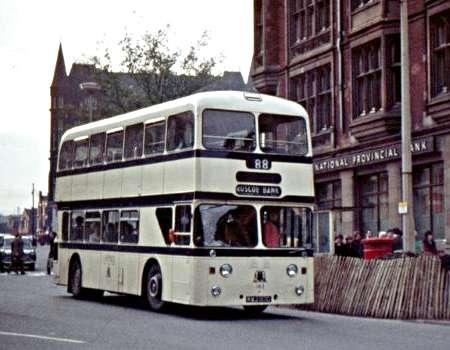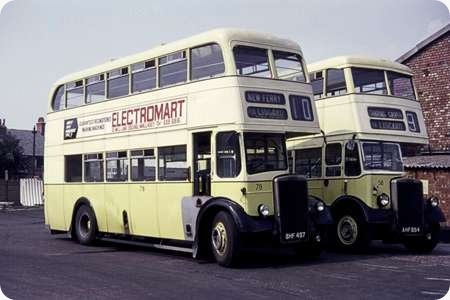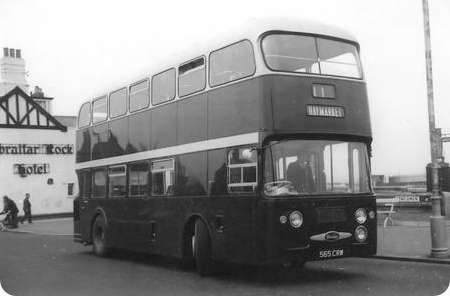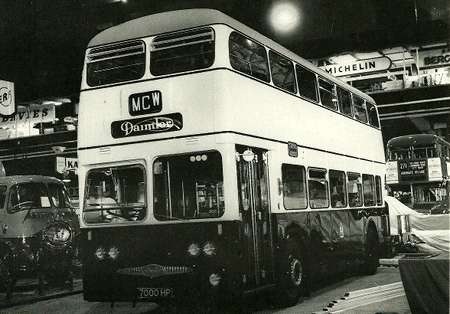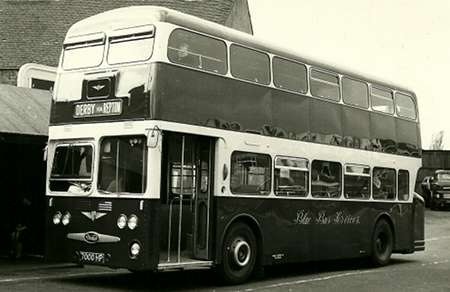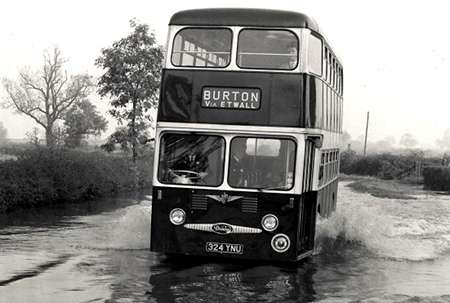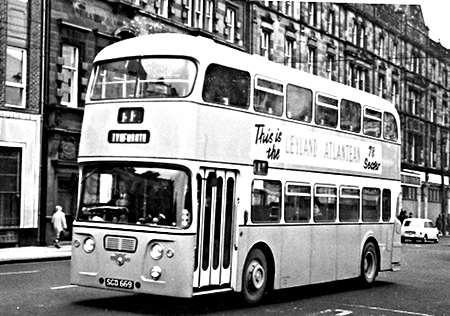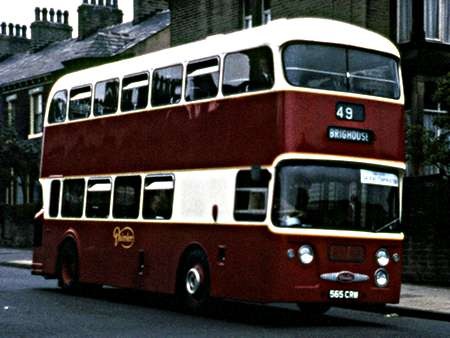Sheffield Corporation – Leyland Atlantean – KWJ 163D – 163
Sheffield Corporation
1966
Leyland Atlantean PDR1/2
Neepsend H44/33F
There were 40 of these Atlanteans in Sheffield in two batches of 20. This is one of the second batch delivered with blue interiors and wheels together with three rotovents in each side of the upper deck in lieu of sliding windows. These were quite effective in extracting the tobacco fug without causing too much draught but must have been difficult to clean. A facing crossover on the Supertram network now adorns this location allowing trams to reverse in front of the cathedral. The cream and blue livery contrasts with the blackened facade of the National Provincial Bank. I liked these buses with the deep windows in each deck and a touch of modernity with the curved windscreens. Pity the transmission design was not more robust. There was a touch of local pride with the bodies being ‘Built in Sheffield’. The photo was taken in 1967 when the bus was about one year old.
Photograph and Copy contributed by Ian Wild
02/03/14 – 08:19
The rotovents may have extracted smoke but they were worse than useless for providing ventilation in the heat of summer. It’s a moot point about the quality of either these or the contemporary Park Royal bodies as the transmission on the PDR1/2 gave the buses the violent shakes when the buses were at rest. This was even more pronounced if they were left in gear at a stop, traffic lights or give way signs.
Interesting operational point to ponder. The 88 went from Fulwood (one of the wealthiest parts of the city) to Roscoe Bank (a housing estate to the north – just short of Stannington). This was a common feature of cross-city routes – going from a wealthy suburb to a housing estate or a deprived &/or slum area (often in the East End). Did this happen in other towns and cities?
David Oldfield
02/03/14 – 15:42
I think I ought to defend the NatPro bank in this picture, Ian as like most buildings in Central Sheffield by that time, it looks cleaned, and is terracotta and stone. "blackened Facades" in post war Sheffield really were black- for years, people thought the Town Hall was built of coal.
As for vibrations, nothing but nothing can be worse than First’s Optare midibus on the Leeds Citybus route: at every pause, you can feel your brain being vibrated to mush. Progress- what progress?
Joe
03/03/14 – 07:35
Could anyone in the know prove or disprove the story that the wheels on Sheffield buses were red when Labour were in power and blue when the Tories were in power.
On the subject or routes running from rich to poor areas in Leeds the 2 and still run from affluent Roundhay to the vast Middleton estate in the south of the city
Chris Hough
03/03/14 – 07:36
Was this to Sheffield’s own specification, as most of the East Lancs and Neepsend output on rear engined double deckers seems to have been of the Bolton and Southampton style by this time?
Pete Davies
03/03/14 – 07:37
Have I read somewhere that Sheffield painted bus wheels according to the political party running the council? Red when Labour were in power and blue when the Tories were in charge? (the latter infrequently I would imagine)
Michael Keeley
03/03/14 – 07:38
What is the point of the blacked-out window "(not) illuminating" the staircase? Surely the point of a window is to allow light through – the only point of blacking a window out is to keep light out . . . so why build a blacked-out window in to start with?
Philip Rushworth
03/03/14 – 07:38
The pairing of services to rich and poor areas of a city to form a cross-city route may have been quite common for geographical reasons. In a typical city, richer and poorer suburbs have historically grown up on opposite sides of the centre because of the direction of the prevailing winds, the most desirable places to live being upwind of industrial pollution sources. And the most typical cross-city services tend to go from one side of the city to the other.
Fulwood to Roscoe Bank probably did not fall clearly into this pattern – both termini being basically west of centre – but I don’t know if other Sheffield services did.
Peter Williamson
03/03/14 – 15:13
Apparently the first Sheffield vehicle with blue wheel hubs was Atlantean/Park Royal No. 340, exhibited at the Earl’s Court Motor Show in 1963/4.
Geoff Kerr
03/03/14 – 16:01
Peter- this idea of joining places for routes across a city works well in its simplest form: but you wonder sometimes if it gave all drivers (and their buses) a share of the nice, quieter bits or even if the poorer areas subsidised the richer- who still had to be served. Sheffield (and Huddersfield and some other places) is not what it seems on a map. Steep river valleys mean that places in different valleys look close but are a long way apart by bus, if it has to go into town down one valley then out again up another. A trap for the unwary modern bus executive, in a safe office, miles away.
Philip- I think blacked out windows did let light in- the glass is black, not painted- think of those sinister black Saturday night specials (but now illegal up front).
And, all, I think it was thought that the blue wheels co-incided too co-incidentally with the Tories actually gaining power- but it was such an odd happening that I think people let them have their moment of glory!
Joe
03/03/14 – 16:59
Most of Sheffield’s main cross-city bus services were based on the tram routes they replaced, and over the years the tramway network had been gradually extended to serve the large housing estates as they were developed in the 1920’s and 30’s, and linking them to the industrial area of the east end where the vast majority of Sheffielders went to work every day.
One of the last extensions to the tramway system, if not the very last, was along Abbey Lane, a highly desirable area of the city where the trams ran in a central reservation amid much greenery and overall affluence. In fact, to highlight what a city of contrasts Sheffield is, the last route to be converted to buses ran from Beauchief, the site of a ruined abbey at one end of Abbey Lane, through the city centre to the aptly named Vulcan Road, a siding amid acres of forges, steelworks and soot-blackened terraced houses. And as if to add insult to injury, the cars passed right by Wards yard in Attercliffe on the way, where they were eventually reduced to scrap metal to feed those very same blast furnaces.
Dave Careless
03/03/14 – 17:03
Yes. Roscoe Bank and Fulwood are close as the crow flies – but that is up to Lodge Moor, across Rivelin Valley and down from Stannington. By 88, the distance is at least double – if not more. The route shape is more like a (open ended) paper clip with the U turn in town. The current 25 (Bradway – Woodhouse) is like a letter A. South West, North to Town and then South East.
David Oldfield
04/03/14 – 07:11
On the subject of desk wallahs not knowing the terrain a classic was the Northern Health Authority which was formed because the east and west coasts were only a few miles apart unfortunately they forgot about the Pennines!
Chris Hough
04/03/14 – 07:12
It’s difficult to tell from the photograph but were these vehicles built to normal height, i.e. 14ft 6in? If they were, then presumably the reason for specifying the PDR1/2 chassis to achieve a flat floor on the lower deck . I know Sheffield had only a minimal requirement for low height/lowbridge double deckers, surely they wouldn’t have ordered forty of them?
Chris Barker
04/03/14 – 08:26
Off the top of my head, I think that in 1966 STD had 99 (a memorable but odd number of) PDR1/2s. The balance had full height Park Royal bodies. I seem to remember that the Neepsend bodies were lower height – but how much lower I don’t know – or whether they were low-height in the accepted sense.
David Oldfield
04/03/14 – 08:28
These buses could fit under the bridge on the old 70 route to Upton, hence they were to a slightly lower overall height.
Fulwood may well be posh, but Stannington isn’t exactly the depths of poverty! It is one of Sheffield’s more desirable council estates. Roscoe Bank has now morphed into Hall Park Head after the terminus moved further up the hill as housing expanded.
The Conservatives were only in power for one year and the wheels were painted from red to blue. However, at certain times, bus wheels have been black as well as blue. It is also worth pointing out that the red line below the bottom blue band only ceased to be applied after the signwriter retired. These days, you would apply it in vinyl.
Neil Hudson
04/03/14 – 12:04
The design was not unique to Sheffield. Bury, Warrington and Coventry had identical or almost identical bodies on vehicles of the same period.
Blacked out windows did let in light but were opaque from the outside for purposes of "modesty" given their position.
Phil Blinkhorn
04/03/14 – 12:05
This style of East Lancs body was also bought by Warrington.
Chris Hough
04/03/14 – 12:05
Stannington is "very nice". Had I not had to move south with work. Stannington was always high on the list of possible places to live.
David Oldfield
04/03/14 – 15:54
The blacked out window stopped people looking at passengers going up the stairs from the outside it did let a lot of light in just like ambulances and looked the part.
Dragon
05/03/14 – 07:05
Okay, so others bought this same design. Thanks, folks, but was it actually designed FOR an operator or was it the East Lancs/Neepsend ‘standard’ of the time, which some operators (such as Bolton and Southampton) chose not to use?
Pete Davies
05/03/14 – 16:20
Pete. As far as was possible, this was an East Lancs standard design. More to the point, it was well known that there really was no such thing as an East Lancs standard as they were prepared, more than any other coachbuilder, to build a bespoke design for anyone who asked. Bolton were a case in point who had their own individual designs. Southampton’s Atlanteans were really a more modern development or evolution of this earlier design.
David Oldfield
05/03/14 – 16:22
Bolton always incorporated their own ideas into their bodies by the time Southampton bought Atlanteans a single piece wrap round windscreen was standard as was a peak to the front dome.
Chris Hough
Quick links to the - Comments Page - Contact Page - Home Page
